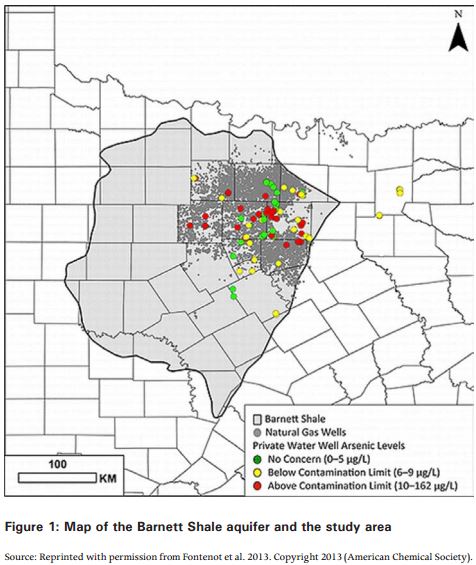Scientists Find ‘Alarming’ Amount Of Arsenic In Groundwater Near Texas Fracking Sites by Emily Atkin, September 2, 201, Think Progress
After testing 100 water wells atop one of the largest natural gas reserves in the U.S., scientists at the University of Texas have found that nearly 30 percent of them contain levels of arsenic above the limit considered safe by the U.S. Environmental Protection Agency, according to a study published in the journal Environmental Science and Technology.
Twenty-nine groundwater sites within 1.8 miles of active natural gas drilling had unusually high levels of heavy metals, including arsenic, the study found. And while it’s not conclusive that the contamination is because of fracking, the team of 11 biochemists say their findings provide further evidence that could link the controversial natural gas drilling technique to groundwater pollution.
[Alberta Environment monitoring water wells in Rosebud, drilling supervised by the Alberta Research Council (now Alberta Innovates), have arsenic in the water. Chromium was also found, and much higher than any other community monitoring wells tested by the regulator and compared with by the Research Council. The research council did not report this in any of their Rosebud drinking water contamination investigation reviews and the regulator did not warn the community.]
“I can’t say we have a smoking gun. We don’t want the public to take away from this that we have pegged fracking as the cause of these issues,” Brian Fontenot, the paper’s lead author, told ProPublica. “But we have shown that these issues do occur in close relation, geographically, to natural gas extraction.”
The EPA classifies arsenic as a carcinogen, and warns that long-term exposure to it can cause cancer, cardiovascular disease, immunological disorders, diabetes and other medical issues.
… That boom started about 10 years ago, and the University of Texas researchers compared their results with previous water tests conducted before that boom. What they found was what researcher Zacariah Hildenbrand called an “alarming” increase in the amount of arsenic and other heavy metals in 30 percent of the groundwater wells within 1.8 miles of gas drilling sites.
“This is indirect evidence that drilling does affect the water,” Hildenbrand said. [Emphasis added]
UTA study: Arsenic level higher in wells near Barnett Shale drilling by Associated Press, August 31, 2014, Statesman
Study finds more arsenic in north Texas water wells near drilling by Associated Press, September 1, 2014, FuelFix
North Texas water wells within two miles of active gas drilling sites contain higher concentrations of arsenic and other carcinogens, according to a study published in the journal Environmental Science and Technology.
In the study, University of Texas at Arlington biochemists measured 100 wells across the Barnett Shale, believed to hold one of the largest natural gas reserves in the U.S., and compared the results to a similar study undertaken before hydraulic fracturing technology and higher natural gas prices opened the area to drilling.
Some 30 percent of the wells within 1.8 miles of gas drilling sites showed an increased amount of arsenic and other heavy metals, the study said, and 29 wells exceeded the Environmental Protection Agency’s maximum arsenic limits of 10 parts per billion.
One of the researchers, UTA biochemist Zacariah Hildenbrand, told The Denton Record-Chronicle that “to find that high of arsenic concentrations was alarming.”
“This is indirect evidence that drilling does affect the water,” he said.
Researchers believe the wells were contaminated when shaking caused by fracking knocked rust off old pipes and into fresh water. But Texas Alliance of Energy Producers spokesman Alex Mills called the theory “a little farfetched.”
An industry veteran, Mills said natural gas wells are drilled so deep that vibrations from drilling would never reach far shallower water wells. [When will industry, its lobby groups, captured regulators and politicians stop lying? There is ample industry evidence proving that companies are not only fracturing near fresh water aquifers, but also directly into them, even those actively used by communities, farms and families]
Researchers also said in the study that higher concentrations of heavy metals could alternatively be the result of the lowering of the water table or faulty casings around gas drilling operations, which would allow contaminants to flow up through the well bore and into aquifers and other supplies of drinking water.
A team of researchers at Southern Methodist University are also studying the Barnett Shale, trying to determine whether fracking — which involves blasting water, sand and chemicals deep into underground rock formations to free oil and gas — and the disposal of vast amounts of wastewater into injection wells has caused an unprecedented series of earthquakes.
Fracking produces millions of gallons of chemical-laced wastewater. The liquid, called brine, is a mix of chemicals, saltwater, naturally occurring radioactive material and mud, and is considered unsafe for ground water and aquifers. [Emphasis added]
New perspectives on the effects of natural gas extraction on groundwater quality by Zacariah L. Hildenbrand, Brian E. Fontenot, Doug D. Carlton Jr and Kevin A. Schug, all at The University of Texas at Arlington, United States, May 24, 2014, in Global Water, Issues and Insights by R. Quentin Grafton, Paul Wyrwoll, Chris White and David Allendes, May 2014
ISBN 9781925021660 (Print version)
ISBN 9781925021677 (Online)
This book brings together some of the world’s leading water researchers with an especially written collection of chapters on: water economics; transboundary water; water and development; water and energy; and water concepts.
“Our analyses revealed levels of heavy metals above the US Environmental Protection Agency’s Maximum Contaminant Limit (MCL) for drinking water in private water well samples collected near natural gas extraction sites. Most notably, 29 of the 91 samples collected within five kilometres of an active natural gas extraction site had arsenic concentrations above the MCL of ten parts per billion (ppb), with a maximum concentration of 161 ppb.
The maximum concentration discovered in one well was nearly 18 times greater than both the maximum concentration sampled from private water well samples located more than 14 kilometres from any active gas wells and the maximum concentration sampled from historical data collected in the Barnett Shale prior to the expansion of unconventional extraction activities (http://www.twdb.state.tx.us/groundwater/data/). We also found selenium and strontium at elevated concentrations, with selenium detected exclusively within two kilometres of natural gas wells.”
One plausible explanation for the observed results involves large withdrawals of
groundwater used in hydraulic fracturing operations that could cause localised
declines in the water table. Such decreases can be associated with higher
arsenic content in waters drawn from shallow water wells (Reedy et al. 2007).
Another scenario to explain elevated heavy metals could be the mechanical
vibrations produced from unconventional drilling activity. In this scenario,
vibrations from nearby intense drilling activity could mechanically disturb a
poorly maintained private water well that has accumulated rust, sulfate and/or
carbonate scale. Once the rust and scale in the water well are disturbed, arsenic,
selenium and strontium that were previously bound in oxide complexes could
be mechanically liberated and released into the well water (Fontenot et al. 2013).
[Refer also to:
At Encana we’re proud—having implemented this practice—of taking the step to eliminate the use of diesel, benzene, and heavy metals, such as cadmium, arsenic, chromium, lead, and mercury in our hydraulic fracturing fluids. [Emphasis added]
Tests on the Ernst water by Encana and the regulator show chromium increased by a factor of 45 (before fracing the aquifer, Encana test showed the chromium below detection level), and barium and strontium doubled after Encana frac’d the aquifer that supplies it.
August 2013: UTA Study Finds Contaminants In Ground Water Near Gas Wells
April 2013: Arsenic Uptake in Homegrown Vegetables from Mining-Affected Soils
Federal health officials are assessing risks related to elevated levels of arsenic, barium, manganese, and methane in an aquifer that supplies homes in a shale gas production zone in Dimock, Pa.
March 2012: Dimock: water supplies tested by EPA
Dimock resident Scott Ely said his test results showed five compounds above their trigger levels, including arsenic, chromium, lithium, sodium and fluoride.
February 2012: Calls for CSG moratorium after ‘toxic spill’
The samples showed lead at five times the acceptable drinking water standard, arsenic at twice and chromium at 3.74 times the acceptable standards….
“Our tests of the Pilliga spill have revealed for the first time just how toxic this coal seam gas water is – it is a cocktail of heavy metals, such as lead and arsenic, plus salts and petrochemicals,”…. [Emphasis added]
April 2011: Families blast gas exploration
The water test revealed high doses of lead, strontium, barium, arsenic, radium and other chemicals, she said, and she immediately stopped drinking the water, but the damage had been done. She broke down as she described the results of a blood test her doctors ordered last week, it was found to contain high levels of barium, which can cause heart and liver damage, as well as the other symptoms she experienced. She said she is extremely concerned especially about the high levels of lead in the water and how it could affect her child’s brain and internal organs.
Though she is feeling better since she stopped drinking the water, her barium levels remain high, at 110 as opposed to 0-10, considered normal, and she is trying to flush the poison from her system by drinking bottled water and taking potassium to replace what the barium has leached from her system, she said. [Emphasis added]
December 2010: North Texas Residents Lawsuits Claim Gas Drilling Contaminated Water
The Harris’ filed their suit against Oklahoma-based Devon Energy, alleging that gas drilling is polluting their drinking water with high levels of aluminum, arsenic, barium and lead. “We started getting a grey substance coming out of our water,” Doug Harris said. “We have no water. We have to go to the Laundromat. We have to get bottled water for all of our dogs and horses.” Dallas attorney Windle Turley represents the Harris family. He has also filed another suit on behalf of Crowley resident Grace Mitchell against Oklahoma-based Chesapeake Energy and Colorado-based Encana Oil & Gas alleging similar damages. [Emphasis added]
PERFECT BASELINE TESTS
Baseline tests on Zimmermann’s water a year before drilling began were “perfect,” he said. In June, water tests found arsenic at 2,600 times acceptable levels, benzene at 44 times above limits and naphthalene five times the federal standard. Soil samples detected mercury and selenium above official limits, as well as ethylbenzene, a chemical used in drilling, and trichloroethene, a naturally occurring but toxic chemical that can be brought to the surface by gas drilling. The chemicals can cause many serious illnesses including damage to the immune, nervous and respiratory systems…. [Emphasis added]
July 2006: Texas Lawsuit Includes a Mix of Race and Water
But they and neighbors in this historically black enclave in the East Texas oilfields seem no closer to being able to drink, cook or bathe safely from their own wells since the E.P.A. found the groundwater contaminated with pollutants that included arsenic, benzene, lead and mercury.
… But almost two decades after Mrs. Roberson first began complaining, setting off years of inconclusive state inquiries, the agency says it is now moving against a large oilfield services company that deposited wastes at a nearby disposal site that has since been closed.
…
“I look at this as poisoning the only source of groundwater,” he said, “as tantamount to lynching.” [Emphasis added]


